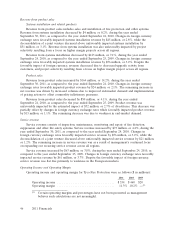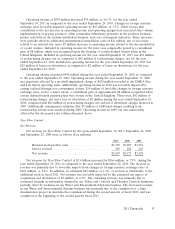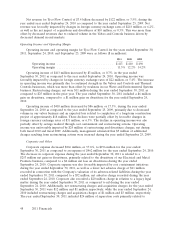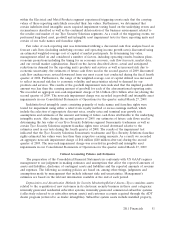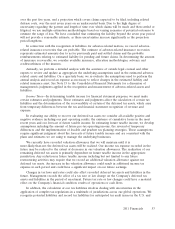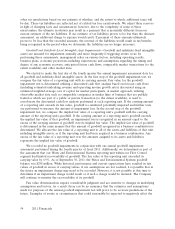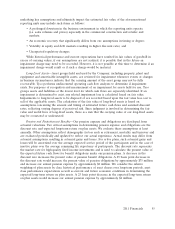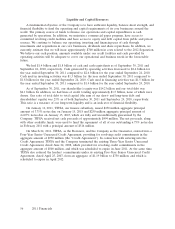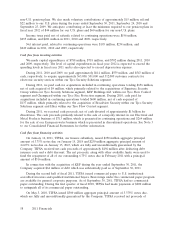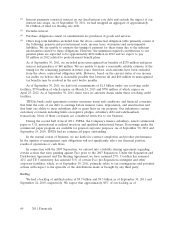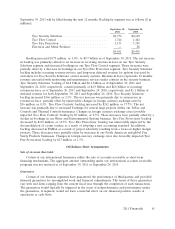ADT 2011 Annual Report Download - page 155
Download and view the complete annual report
Please find page 155 of the 2011 ADT annual report below. You can navigate through the pages in the report by either clicking on the pages listed below, or by using the keyword search tool below to find specific information within the annual report.plant and equipment for which Tyco retains ownership and deferred costs directly related to the
customer acquisition and system installation. Subscriber system assets and any deferred revenue
resulting from the customer acquisition are accounted for over the expected life of the subscriber. In
certain geographical areas where the Company has a large number of customers that behave in a
similar manner over time, the Company accounts for subscriber system assets and related deferred
revenue using pools, with separate pools for the components of subscriber system assets and any
related deferred revenue based on the month and year of acquisition. The Company depreciates its
pooled subscriber system assets (primarily in North America) and related deferred revenue using an
accelerated method with lives up to 15 years. The accelerated method utilizes declining balance rates
based on geographical area ranging from 160% to 265% for residential subscriber pools and 135% to
360% for commercial subscriber pools and converts to a straight line methodology when the resulting
depreciation charge is greater than that from the accelerated method. The Company uses a straight-line
method with a 14-year life for non-pooled subscriber system assets (primarily in Europe and Asia) and
related deferred revenue, with remaining balances written off upon customer termination.
Revenue Recognition—Contract sales for the installation of fire protection systems, large security
intruder systems and other construction-related projects are recorded primarily under the
percentage-of-completion method. Profits recognized on contracts in process are based upon estimated
contract revenue and related total cost of the project at completion. The risk of this methodology is its
dependence upon estimates of costs at completion, which are subject to the uncertainties inherent in
long-term contracts. Provisions for anticipated losses are made in the period in which they become
determinable.
Sales of security monitoring systems may have multiple elements, including equipment, installation,
monitoring services and maintenance agreements. We assess our revenue arrangements to determine
the appropriate units of accounting. When ownership of the system is transferred to the customer, each
deliverable provided under the arrangement is considered a separate unit of accounting. Revenues
associated with sale of equipment and related installations are recognized once delivery, installation and
customer acceptance is completed, while the revenue for monitoring and maintenance services are
recognized as services are rendered. Amounts assigned to each unit of accounting are based on an
allocation of total arrangement consideration using a hierarchy of estimated selling price for the
deliverables. The selling price used for each deliverable will be based on Vendor Specific Objective
Evidence (‘‘VSOE’’) if available, Third Party Evidence (‘‘TPE’’) if VSOE is not available, or estimated
selling price if neither VSOE or TPE is available. Revenue recognized for equipment and installation is
limited to the lesser of their allocated amounts under the estimated selling price hierarchy or the
non-contingent up-front consideration received at the time of installation, since collection of future
amounts under the arrangement with the customer is contingent upon the delivery of monitoring and
maintenance services.
Product discounts granted are based on the terms of arrangements with direct, indirect and other
market participants. Rebates are estimated based on sales terms, historical experience and trend
analysis.
Loss Contingencies—Accruals are recorded for various contingencies including legal proceedings,
self-insurance and other claims that arise in the normal course of business. The accruals are based on
judgment, the probability of losses and, where applicable, the consideration of opinions of internal
and/or external legal counsel and actuarially determined estimates. Additionally, the Company records
receivables from third party insurers when recovery has been determined to be probable.
Asbestos-Related Contingencies and Insurance Receivables—We and certain of our subsidiaries along
with numerous other companies are named as defendants in personal injury lawsuits based on alleged
exposure to asbestos-containing materials. We estimate the liability and corresponding insurance
recovery for pending and future claims and defense costs predominantly based on claim experience
52 2011 Financials






